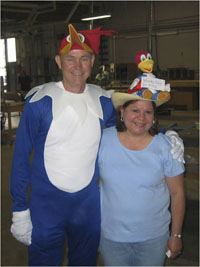ONLINE EXCLUSIVE: Woodfold: Make Continuous Improvement Easy
Lea A.P. Tonkin, editor in chief
How do you motivate associates when you’re in the midst of a recession marked by reduced hours and layoffs? For Woodfold Manufacturing, Inc., in Forest Grove, OR, the answer is easy. It’s actually the “Woodfold Do Easy” approach, built on employee involvement and lean understanding nurtured during the past several years, explained Mark Lewis, president. Lewis will discuss the company’s improvement practices and results during the October 24-28 Association for Manufacturing Excellence (AME) annual “Excellence Inside” conference in Dallas. Woodfold associates manufacture accordion folding doors, interior wood shutters, and wood roll-up doors.
 |
| Employees implement improvements that make their jobs easier in the Woodfold Manufacturing, Inc. Woodfold Do Easy program. Dressed as Woody the Woodpecker, Mark Lewis, president, is accompanied by Connie Maciel, an employee owner. |
“By October 2008, our sales dropped almost in half,” Lewis said. ”Our workforce decreased from 108 to 68 by January 2010. Although productivity gains continued, we looked for a new way to encourage and implement employees’ improvement ideas.” Woodfold Do Easy, featuring mascot Woody the Woodpecker, launched in January 2011.
Leadership at the employee-owned company aimed to mine employees’ innovative ideas while avoiding the paperwork and delays that hinder many companies’ suggestion programs. Employees make process improvement changes without waiting for the green light from management. An added benefit: making associates’ jobs easier, thanks to implemented improvements. With no formal budget for Woodfold Do Easy, the program is already off to a great start. Many improvements are free; the highest-priced improvement so far cost $50.
Employees’ setup reduction changes yielded productivity gains, and much more. “We’re asking people to make their jobs easier as they look for ways to improve, leading to a dramatic change in perspective and many more ideas than we’d anticipated,” Lewis said. “It’s remarkable.”
Cost savings continue to rise along with the number of implemented improvements. For example, on small jobs, an employee set up and started running an unused small dust collection system that cost 20 cents an hour to run, instead of a larger unit that cost $20 per hour.
Another innovation prompted by an employee: By running wood more slowly through a molder, employees could achieve better smoothness in the product and in turn eliminate multiple sanding steps and one lacquer finish coat. Where an operator previously revved up a huge bank of lights when starting a machine, now a single small light does the trick. An operator who paints hinges developed a new process that cuts setup time; parts are rotated to eliminate wasted steps.
In the first six months since Woodfold started the program, the plant benefited from more than 110 ‘Woodies’ (implemented changes that made people’s work easier). Employees document their improvements and then are recognized for their bright ideas. “We take a picture of the implemented change and then discuss it at our standup meeting in the morning,” said Lewis. “The employee explains it, so it might be used in other areas of the plant.” Associates put colored stickers on whiteboards posted in the plant, indicating improvement sites.
This “easy” approach also took hold in office areas. Staffers’ ideas nixed unnecessary reports and paper flow. Associates networked computers so information could be more easily shared. Thanks to a process simplification change, office employees trimmed the time previously spent matching credit card bills.
“It’s empowering employees,” Lewis said. “They don’t have to ask for permission to make changes. The only restriction on innovative ideas: They should not adversely affect safety or quality, nor should they change the form, fit, or function of the product."
Lessons Learned
Lewis shared lessons learned from Woodfold Do Easy include:
- Tailor idea implementation programs to your own organization
- Believe in your people and trust them
- Less is more; you don’t need to do a productivity study or see all the details of an improvement before it’s implemented.
“This is a doing system, not a suggestion system,” said Lewis, noting that it dovetails with Woodfold’s lean activities such as targeted improvement projects. “We’re working hard to make excellence easy.”


